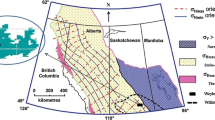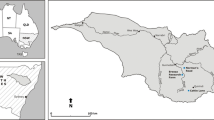Abstract
We use a relatively simple analytic model incorporating two primary geomechanical factors–in situ stress and frictional coefficient of discontinuity–to assess the critical pore pressure increase associated with CO2 geological storage that initiates shear activation of pre-existing fractures and faults. Shear activation of fractures/faults can break the sealing integrity along the discontinuities, providing possible CO2 leakage channels. With an example of Gyeongsang Basin, Korea, which is considered a potential onshore geological storage site, the available in situ stress measurement data are analyzed to infer the stress states at an assumed storage depth of 1 km. The stress magnitudes in the basin are characterized by their spatial heterogeneity, implying that the critical pore pressure may vary depending on locations. As another primary factor for the analysis, frictional coefficient is shown to be possibly correlated with clay content in the host rocks encompassing the discontinuities, and in the infillings within the discontinuities, which demonstrates the possibility of estimating the frictional property from the clay content measurable using borehole geophysical logs. Based on the in situ stress conditions coupled with pore pressure change and assumed frictional coefficient of 0.6, the critical pore pressure is estimated, which would induce shear activation along well-orientated discontinuities for slip under the given stress states and consequently provide potential CO2 leakage pathways. The estimated critical pore pressure as an upper bound of allowable pore pressure is 4–8 MPa above the hydrostatic pore pressure in most of the basin, whereas the same is 0–4 MPa in the southern part of the basin. These results may be useful in the site selection stage for CO2 geological storage project.
Similar content being viewed by others
References
Anderson, E.M., 1951, The Dynamics of Faulting and Dyke Formation with Applications to Britain. Oliver and Boyd, Edinburgh, 206 p.
Bae, S.-H., Jeon, S.-W., Kim, J.-M., and Kim, J.-S., 2008, Characteristics of the regional rock stress field at shallow depth in the Kyungsang Basin with in-situ rock stress measurement. Tunnel & Underground Space, 18, 149–161. (in Korean with English abstract)
Bandis, S., 1980, Experimental Studies of Scale Effects on Shear Strength, and Deformation of Rock Joints. Ph.D. Thesis, University of Leeds, Leeds, 385 p.
Barton, N. and Choubey, V., 1977, The shear strength of rock joints in theory and practice. Rock Mechanics, 10, 1–54.
Byerlee, J., 1978, Friction of rocks. Pure and Applied Geophysics, 116, 615–626.
Byerlee, J.D., 1993, Model for episodic flow of high-pressure water in fault zones before earthquakes. Geology, 21, 303–306.
Challen, J. and Oxley, P., 1979, An explanation of the different regimes of friction and wear using asperity deformation models. Wear, 53, 229–243.
Chang, C., Lee, J.B., and Kang, T.-S., 2010, Interaction between regional stress state and faults: Complementary analysis of borehole in situ stress and earthquake focal mechanism in southeastern Korea. Tectonophysics, 485, 164–177.
Chang, C., Jo, Y., Quach, N., Shinn, Y., Song, I., and Kwon, Y., 2016, Geomechanical characterization for the CO2 injection test site, offshore Pohang Basin, SE Korea. Proceedings of 50th US Rock Mechanics/ Geomechanics Symposium, Houston, June 26–29, p. 1064–1069.
Chiaramonte, L., Zoback, M.D., Friedmann, J., and Stamp, V., 2008, Seal integrity and feasibility of CO2 sequestration in the Teapot Dome EOR pilot: geomechanical site characterization. Environmental Geology, 54, 1667–1675.
Crawford, B., Faulkner, D., and Rutter, E., 2008, Strength, porosity, and permeability development during hydrostatic and shear loading of synthetic quartz-clay fault gouge. Journal of Geophysical Research, 113, B03207.
Egawa, K., Hong, S., Lee, H., Choi, T., Lee, M., Kang, J., Yoo, K., Kim, J., Lee, Y., and Kihm, J., 2009, Preliminary evaluation of geological storage capacity of carbon dioxide in sandstones of the Sindong Group, Gyeongsang Basin (Cretaceous). Journal of the Geological Society of Korea, 45, 463–472. (in Korean with English abstract)
Engelder, T. and Fischer, M.P., 1994, Influence of poroelastic behavior on the magnitude of minimum horizontal stress, Sh, in overpressured parts of sedimentary basins. Geology, 22, 949–952.
Haimson, B.C. and Cornet, F.H., 2003, ISRM Suggested Methods for rock stress estimation–Part 3: hydraulic fracturing (HF) and/or hydraulic testing of pre-existing fractures (HTPF). International Journal of Rock Mechanics and Mining Sciences, 40, 1011–1020.
Hawkes, C., McLellan, P., and Bachu, S., 2005, Geomechanical factors affecting geological storage of CO2 in depleted oil and gas reservoirs. Journal of Canadian Petroleum Technology, 44, 52–61.
Heidbach, O., Tingay, M., Barth, A., Reinecker, J., Kurfeß, D., and Müller, B., 2008, The 2008 Release of the World Stress Map. Helmholtz-Centre Potsdam–GFZ German Research Centre for Geosciences.
Hillis, R.R., 2001, Coupled changes in pore pressure and stress in oil fields and sedimentary basins. Petroleum Geoscience, 7, 419–425.
Homberg, C., Hu, J.C., Angelier, J., Bergerat, F., and Lacombe, O., 1997, Characterization of stress perturbations near major fault zones: insights from 2-D distinct-element numerical modelling and field studies (Jura mountains). Journal of Structural Geology, 19, 703–718.
Hong, T.-K. and Choi, H., 2012, Seismological constraints on the collision belt between the North and South China blocks in the Yellow Sea. Tectonophysics, 570, 102–113.
Hurst, A., 1990, Natural gamma-ray spectrometry in hydrocarbon-bearing sandstones from the Norwegian Continental Shelf. Geological Society of London, Special Publications, 48, p. 211–222.
Jaeger, J.C., Cook, N.G., and Zimmerman, R., 2009, Fundamentals of Rock Mechanics. John Wiley & Sons, Chichester, 488 p.
Juanes, R., Hager, B.H., and Herzog, H.J., 2012, No geologic evidence that seismicity causes fault leakage that would render large-scale carbon capture and storage unsuccessful. Proceedings of the National Academy of Sciences, 109, E3623–E3623.
Kang, Y.-A., Kim, W., and Kang, T.-S., 2013, Relocation of earthquakes beneath the East Sea of Korea: uncertainty of hypocentral parameters caused by refracted waves. Geosciences Journal, 17, 173–182.
Kim, A.-R., Cho, G.-C., and Kwon, T.-H., 2014, Site characterization and geotechnical aspects on geological storage of CO2 in Korea. Geosciences Journal, 18, 167–179.
Lackner, K.S., 2003, A guide to CO2 sequestration. Science, 300, 1677–1678.
Lee, J.-Y., Weingarten, M., and Ge, S., 2016, Induced seismicity: the potential hazard from shale gas development and CO2 geologic storage. Geosciences Journal, 20, 137–148.
Lee, J.B. and Chang, C., 2009, Slip tendency of Quaternary faults in southeast Korea under current state of stress. Geosciences Journal, 13, 353–361.
Lee, S. and Chang, C., 2015, Laboratory experimental study on fracture shear-activation induced by carbon dioxide injection. Journal of the Geological Society of Korea, 51, 281–288. (in Korean with English abstract)
Metz, B., Davidson, O., De Coninck, H., Loos, M., and Meyer, L., 2005, IPCC Special Report on Carbon Dioxide Capture and Storage. Cambridge University Press, Cambridge, 442 p.
Moeck, I., Kwiatek, G., and Zimmermann, G., 2009, Slip tendency analysis, fault reactivation potential and induced seismicity in a deep geothermal reservoir. Journal of Structural Geology, 31, 1174–1182.
Paterson, M.S. and Wong, T.-F., 2005, Experimental Rock Deformation-the Brittle Field. Springer Science & Business Media, Berlin, 348 p.
Raleigh, C., Healy, J., and Bredehoeft, J., 1976, An experiment in earthquake control at Rangely, Colorado. Science, 191, 1230–1237.
Ringrose, P., Mathieson, A., Wright, I., Selama, F., Hansen, O., Bissell, R., Saoula, N., and Midgley, J., 2013, The In Salah CO2 storage project: lessons learned and knowledge transfer. Energy Procedia, 37, 6226–6236.
Rutqvist, J. and Tsang, C.-F., 2002, A study of caprock hydromechanical changes associated with CO2-injection into a brine formation. Environmental Geology, 42, 296–305.
Rutqvist, J., Birkholzer, J., Cappa, F., and Tsang, C.-F., 2007, Estimating maximum sustainable injection pressure during geological sequestration of CO2 using coupled fluid flow and geomechanical faultslip analysis. Energy Conversion and Management, 48, 1798–1807.
Sassi, W. and Faure, J.-L., 1997, Role of faults and layer interfaces on the spatial variation of stress regimes in basins: inferences from numerical modelling. Tectonophysics, 266, 101–119.
Savage, W.Z. and Swolfs, H.S., 1986, Tectonic and gravitational stress in long symmetric ridges and valleys. Journal of Geophysical Research, 91, 3677–3685.
Scholz, C. and Engelder, J., 1976, The role of asperity indentation and ploughing in rock friction - I: Asperity creep and stick-slip. International Journal of Rock Mechanics and Mining Sciences & Geomechanics Abstracts, 13, 149–154.
Serra, O., Baldwin, J., and Quirein, J., 1980, Theory, interpretation, and practical applicatons of natural gamma ray spectroscopy. SPWLA 21st Annual Logging Symposium, July 8–11, Lafayette, SPWLA-1980-Q.
Sjöberg, J., Christiansson, R., and Hudson, J.A., 2003, ISRM Suggested Methods for rock stress estimation–Part 2: overcoring methods. International Journal of Rock Mechanics and Mining Sciences, 40, 999–1010.
Streit, J.E. and Hillis, R.R., 2004, Estimating fault stability and sustainable fluid pressures for underground storage of CO2 in porous rock. Energy, 29, 1445–1456.
Takahashi, M., Mizoguchi, K., Kitamura, K., and Masuda, K., 2007, Effects of clay content on the frictional strength and fluid transport property of faults. Journal of Geophysical Research, 112, B08206.
Tembe, S., Lockner, D.A., and Wong, T.F., 2010, Effect of clay content and mineralogy on frictional sliding behavior of simulated gouges: Binary and ternary mixtures of quartz, illite, and montmorillonite. Journal of Geophysical Research, 115, B03416.
Verberne, B.A., He, C., and Spiers, C.J., 2010, Frictional properties of sedimentary rocks and natural fault gouge from the Longmen Shan fault zone, Sichuan, China. Bulletin of the Seismological Society of America, 100, 2767–2790.
Verdon, J.P., Kendall, J.-M., Stork, A.L., Chadwick, R.A., White, D.J., and Bissell, R.C., 2013, Comparison of geomechanical deformation induced by megatonne-scale CO2 storage at Sleipner, Weyburn, and In Salah. Proceedings of the National Academy of Sciences, 110, E2762–E2771.
Vidal-Gilbert, S., Nauroy, J.-F., and Brosse, E., 2009, 3D geomechanical modelling for CO2 geologic storage in the Dogger carbonates of the Paris Basin. International Journal of Greenhouse Gas Control, 3, 288–299.
Vilarrasa, V. and Carrera, J., 2015, Geologic carbon storage is unlikely to trigger large earthquakes and reactivate faults through which CO2 could leak. Proceedings of the National Academy of Sciences, 112, 5938–5943.
Wells, D.L. and Coppersmith, K.J., 1994, New empirical relationships among magnitude, rupture length, rupture width, rupture area, and surface displacement. Bulletin of the Seismological Society of America, 84, 974–1002.
Zoback, M.D. and Harjes, H.-P., 1997, Injection-induced earthquakes and crustal stress at 9 km depth at the KTB deep drilling site, Germany. Journal of Geophysical Research, 102, 18477–18491.
Zoback, M.D. and Zinke, J.C., 2002, Production-induced normal faulting in the Valhall and Ekofisk oil fields. In: Trifu, C.I. (ed.), The Mechanism of Induced Seismicity. Springer, p. 403–420.
Zoback, M.D., Barton, C.A., Brudy, M., Castillo, D.A., Finkbeiner, T., Grollimund, B.R., Moos, D.B., Peska, P., Ward, C.D., and Wiprut, D.J., 2003, Determination of stress orientation and magnitude in deep wells. International Journal of Rock Mechanics and Mining Sciences, 40, 1049–1076.
Zoback, M.D., 2007, Reservoir Geomechanics: Earth Stress and Rock Mechanics Applied to Exploration, Production and Wellbore Stability. Cambridge Press, Cambridge, 449 p.
Zoback, M.D. and Gorelick, S.M., 2012, Earthquake triggering and large-scale geologic storage of carbon dioxide. Proceedings of the National Academy of Sciences, 109, 10164–10168.
Zoback, M.D. and Gorelick, S.M., 2015, To prevent earthquake triggering, pressure changes due to CO2 injection need to be limited. Proceedings of the National Academy of Sciences, 112, E4510–E4510.
Author information
Authors and Affiliations
Corresponding author
Rights and permissions
About this article
Cite this article
Chang, C. Critical pore pressure assessment for CO2 geological storage in Gyeongsang Basin, Korea, from a geomechanics perspective. Geosci J 21, 617–630 (2017). https://doi.org/10.1007/s12303-016-0067-0
Received:
Accepted:
Published:
Issue Date:
DOI: https://doi.org/10.1007/s12303-016-0067-0




